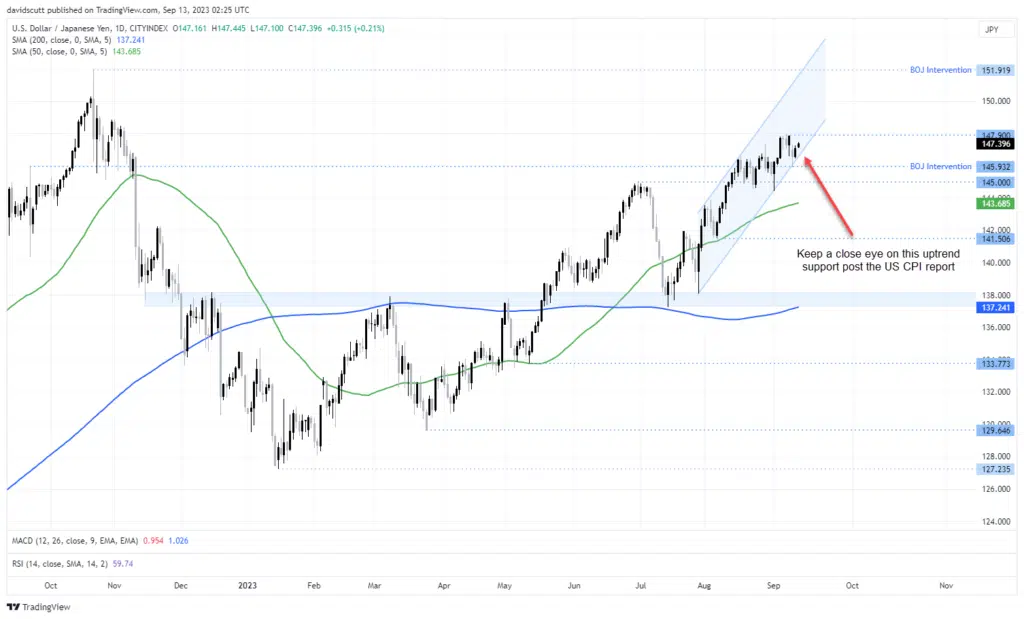The recent remarks by Kazuo Ueda, the Governor of the Bank of Japan (BOJ), have generated significant attention within the foreign exchange (FX) markets. Ueda has raised the prospect of the BOJ potentially discontinuing its implementation of negative interest rates, contingent upon compelling evidence indicating the sustainability of inflationary forces in Japan.
This departure from the prevailing deflationary and disinflationary conditions that have persisted for over three decades has sparked considerable discussion and debate. Ueda emphasized the significance of monitoring sustainability in wage pressures as a critical consideration for the bank.
Flagging Upstream Inflation Hurts USD/JPY Bearish
The latest available data about wages has exhibited a predominantly underwhelming trend, indicating that market speculations regarding an imminent termination of hostile interest rate policy and yield curve control may be premature. Based on the recently published government data, it is evident that nominal pay growth experienced a deceleration in the period spanning from July of the previous year to the present. The growth rate of 1.3% observed during this timeframe is notably less than half of the 2.9% peak achieved merely two months prior, which stands as a multi-decade high.
In light of mounting uncertainties surrounding the long-term viability of the inflationary momentum permeating the economy, it is noteworthy that upstream price dynamics are displaying signs of deceleration, as evidenced by the eighth consecutive monthly moderation in wholesale price expansion on a year-over-year basis during August.
The corporate goods price index (CGPI) published by the government indicates a 3.2% increase compared to the corresponding period of the previous year. This growth rate is significantly lower than the 10.6% annualized rate reported in December 2022.
The potential impact of input costs on subsequent price dynamics is a matter of concern. The deceleration in momentum serves as a cautionary narrative, suggesting that the recent upswing in consumer price inflation may encounter challenges in maintaining its trajectory. This, in turn, contributes to the presence of downward risks about wage pressures as we approach the commencement of annual pay negotiations in the upcoming year.
Given the current challenges faced by Japan’s domestic economy, particularly in terms of weakening household spending, it is understandable that concerns are arising regarding the Bank of Japan’s ability to initiate policy normalization. This concern is further compounded by the contrasting trend observed among other central banks, which are anticipated to pursue interest rate reductions instead.
In light of the government’s expressed apprehension regarding the depreciation of the Japanese yen vis-à-vis the US dollar, it is plausible that Ueda’s actions were merely intended to draw attention to the possibility of normalizing policy as a means to elicit a currency response, thereby preventing the need for direct intervention. The intended outcome was achieved, albeit fleetingly.
The USD/JPY Rise Is Still Going Strong, but It Looks Like It Could Be in Danger
Upon careful examination of the daily chart, it is evident that the currency pair USD/JPY experienced a favorable rebound from the support level of the established upward trend on Monday. This successful recovery effectively mitigated the imminent risk of altering the prevailing trajectory. Given the current indications of inflationary trends in Japan, it is apparent that the overall circumstances point towards a continuation of the most viable course, particularly when juxtaposed with the persistent robustness observed in the United States economy.

The USD/JPY currency pair continues to exhibit susceptibility to potential reversal risks, primarily attributable to the prevailing extent of bullish sentiment surrounding the US dollar. The dominant discourse revolves around soft landings, the inherent danger of a potential resurgence in inflation, and the possibility of implementing higher interest rates.
The prevailing conditions in this particular environment are optimal for the global reserve currency. Suppose the current state of affairs needs to align with the ambitious projections. In that case, it is plausible for the prevailing interest rate disparity between the respective nations to diminish, potentially exerting downward pressure on the USD/JPY exchange rate. A catalyst is required as a preliminary step.
A Big Test Is Coming for USD Bulls
The initial examination pertains to August’s forthcoming United States inflation report, scheduled explicitly for Wednesday. Considerable attention will be directed towards the notable surge in headline acceleration, primarily attributed to the escalation of energy prices. However, it is imperative to underscore the significance of the core figure, as it holds more significant potential to influence market dynamics.
A monthly increase of 0.2% could affect the likelihood of the Federal Reserve maintaining its current stance in September and November, thereby signaling the conclusion of the ongoing tightening cycle. The potential for an uptrend support shift on the daily USD/JPY chart may result in a subsequent movement toward the 145.00 level. Suppose the core reading surpasses the threshold of 0.3% or exceeds it. In that case, the USD/JPY currency pair could be a forceful instrument in encountering resistance slightly below the 148.00 level.


